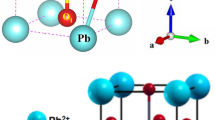Abstract
An interparticle glass matrix in ruthenium dioxide-based thick film resistors has been studied intensively by means of analytical and high resolution transmission electron microscopy. The ruthenium dioxide phase interacts with lead-borosilicate glass at high temperature by dissolving ruthenium ions and incorporating a small number of lead and aluminum ions on the surface. Ruthenium ions diffuse through the glass network at least over a distance of 1 μm during firing, but are accommodated in the glass structure by an amount only less than 7 at. % at room temperature. High resolution electron microscopy reveals numerous ruthenium-pyrochlore crystallites in high-lead glasses, but hardly any Ru-based clusters/crystallites in low-lead glasses, where lead-rich glass clusters due to glass immiscibility and reduced lead metal clusters are more commonly observed instead of ruthenium clusters. Lead oxide is prone to reduction both in high- and low-lead glasses upon irradiating with a high-energy incident electron beam. Comparison with gold-based resistor and estimation of average dispersion length of ruthenium clusters, 2 to 4 nm, prefer the model of electron hopping via ruthenium clusters/crystallites as a dominant conduction mechanism in thick film resistors.
Similar content being viewed by others
References
T. V. Nordstrom and C. R. Hills, J. Hybrid Microelectronics 40, 14 (1980).
L. J. Brady, Proc. IEEE Electronic Components Conf., Washington, DC (1967), p. 238.
M. Prudenziati, Electrocomp. Sci. Tech. 10, 285 (1983).
G.E. Pike and C.H. Seager, J. Appl. Phys. 48, 5152 (1977).
F. Forlani and M. Prudenziati, Electrocomp. Sci. Tech. 3, 77 (1976).
R. M. Hill, Proc. 2nd Europ. Hybrid Microelec. Conf., ISHM (1979), p. 95.
N. F. Mott and E. A. Davis, Electronic Processes in Non-Crystalline Materials, 2nd ed. (Oxford University Press, Oxford, 1979).
R.W. Vest, S.M. Citale, and A.K. Kollipara, Proc. 5th Europ. Hybrid Microelec. Conf., Stresa, Italy (1985), p. 406.
K. Adachi, S. Iida, J. Ishigame, and S. Sekihara, J. Mater. Res. 6, 1729 (1991).
A. Prabhu, G.L. Fuller, and R.W. Vest, J. Am. Ceram. Soc. 57, 408 (1974).
J.I. Goldstein, Introduction to Analytical Electron Microscopy, edited by J. I. Goldstein and D. C. Joy (Plenum Press, New York, 1979), p. 83.
K. Adachi and H. Inage, unpublished research.
D.W. Johnson and F.A. Hummel, J. Am. Ceram. Soc. 51, 196 (1968).
M. Sacchi, M. Antonini, and M. Prudenziati, Phys. Status Solidi A 109, K23 (1988).
F. Sirotti, M. Sacchi, M. Prudenziati, and M. Antonini, Proc. 2nd Europ. Conf. on Prog, in X-ray Synchrotron Rad. Res., SIF, Bologna, Italy (1990), p. 547.
Author information
Authors and Affiliations
Rights and permissions
About this article
Cite this article
Adachi, K., lida, S. & Hayashi, K. Ruthenium clusters in lead-borosilicate glass in thick film resistors. Journal of Materials Research 9, 1866–1878 (1994). https://doi.org/10.1557/JMR.1994.1866
Received:
Accepted:
Published:
Issue Date:
DOI: https://doi.org/10.1557/JMR.1994.1866




